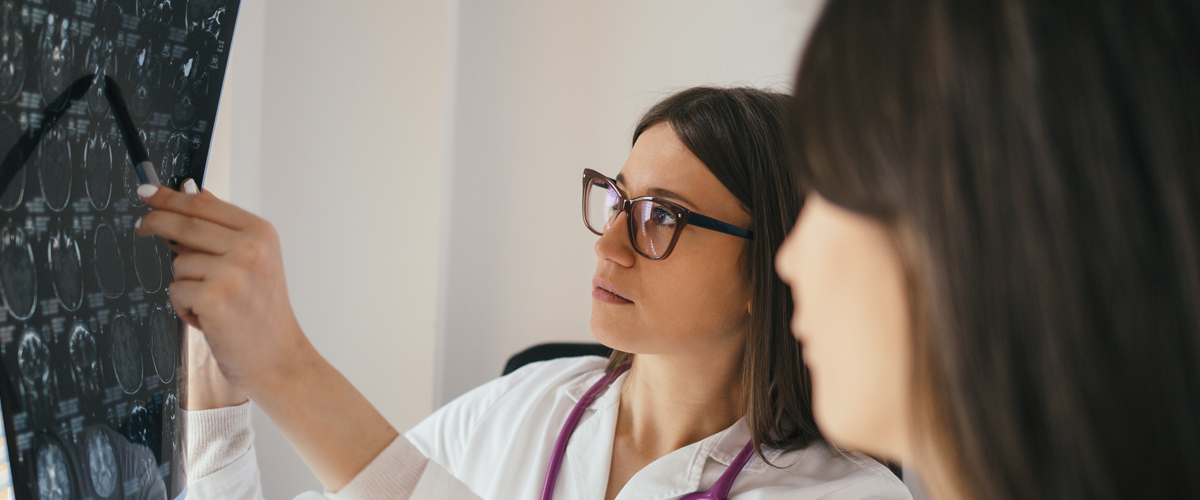Stroke and COVID-19
A neurologist explains why people should not delay seeking medical care for a stroke during the COVID-19 crisis and how providers are using telemedicine to safely provide stroke services.


COVID-19 is known as a respiratory infection that affects the lungs and causes breathing issues, including coughing and shortness of breath. As the virus spreads, it can take a toll on a wide range of other systems in the body, leading to critical conditions such as stroke and heart attack.
At the same time, fear of COVID-19 is preventing some people who are experiencing stroke symptoms and other urgent issues from seeking medical care, particularly in a hospital setting, even though time is of the essence when it comes to stroke and cardiac care. A study from the Journal of the American College of Cardiology found admissions for one serious type of heart attack dropped nearly 40 percent after the pandemic hit.
“The public needs to treat medical emergencies like stroke or a heart attack the same way they did before and not avoid the emergency room because of this crisis,” says Dr. Mitchell Elkind, an attending neurologist on the stroke service at NewYork-Presbyterian/Columbia University Irving Medical Center. “That goes not just for stroke but also for chest pain, shortness of breath, and severe stomach pain that could be an abdominal problem, like appendicitis. People need to get those things evaluated.”
For National Stroke Awareness Month in May, Health Matters spoke to Dr. Elkind to learn why it’s crucial to still go to a hospital if you suffer a stroke, how doctors are pivoting to telemedicine to provide ongoing stroke care, and how COVID-19 might be leading to strokes, including among people who would not typically be considered high risk, such as younger adults.
If you’re having symptoms of a stroke or a mini-stroke, known as a TIA, should you still go to the hospital?
If you think you’re having a stroke of any kind, then you should call 911 and be taken to the hospital. Hospitals are prepared and have implemented infection control measures such as symptom screening, wearing personal protective equipment (e.g., universal masking for staff and patients), limiting visitation, and testing for COVID-19 to keep patients safe. It’s safe to come to the emergency room if you think you’re having symptoms of a stroke. We don’t want people to have heart attacks and strokes and be too afraid to seek critical, timely care.

Are many people delaying care? Why is that dangerous?
Not only are we seeing that the rates of people coming in with strokes and heart attacks are going down, but we’re also seeing that when people do come in, they’re coming in later. They’re delaying seeking help. Often the symptoms or the manifestations are much worse, so it’s harder to treat them if they come in late. With a stroke, for every minute that passes after blood flow is even partially cut off from the brain, approximately 1.9 million brain cells die because of a lack of oxygen, so it’s only a matter of time before vital brain functions are severely affected.
If someone has a stroke, does all their care need to be in person?
No. During the COVID-19 crisis, we’ve continued seeing our patients and running our practices as we were before, except now we’re doing it through video encounters, or telemedicine. Many hospitals, including the NewYork-Presbyterian system, have routinely used telemedicine for stroke care, and in many ways, stroke has been at the forefront of the telemedicine curve. For example, neurologists at NewYork-Presbyterian have used telemedicine to consult with smaller hospitals or remote hospitals that don’t have neurology or stroke expertise to decide on whether to give stroke patients tPA (tissue plasminogen activator, a medicine that can dissolve blood clots), so we’re very comfortable with that. We’re fortunate in one sense that we’ve had this technology developing, so we were able to pull it off the shelf when the crisis hit.
“With a stroke, for every minute that passes after blood flow is even partially cut off from the brain, approximately 1.9 million brain cells die because of a lack of oxygen.”— Dr. Mitchell Elkind
How does telemedicine work for stroke care?
Within our hospital, we’re using telemedicine to evaluate patients in our own emergency room because we want to preserve personal protective equipment and limit the use of masks and gowns. We have begun to use tele-rounding, for example, where one person goes into the room with their smartphone or camera, then we can all participate in the evaluation of that patient even from outside the room. That protects us, it protects the patient, and it protects the use of PPE.
Outside of our hospital we’re also using telemedicine visits to see the person face-to-face over a smartphone, tablet, or computer and do examinations. I can ask people to demonstrate their strength, to hold their hands up. I can look for asymmetries, I can look for eye-movement abnormalities, I can watch them walk, and I can ask them to do mental status tests, or test their language. It’s not perfect, but we can usually tell pretty easily if somebody is having a stroke or significant change in their neurological status by looking at them. We always prefer to lay on hands, but this is pretty close to being able to do that.
We’re also using remote monitoring equipment to collect information on blood pressure, for example, or even blood tests that people may do at home, like blood sugar testing where people have to prick their finger and get a tiny blood sample. Those results can then be digitally transmitted to their doctor. People who’ve had strokes are going to have limited mobility, and it’s going to be hard for them to come in, so if there are things that people can do safely and easily at home and get the information to their doctor that way, then that makes things a lot easier.
Can COVID-19 lead to a stroke?
People who are critically ill with COVID-19 can have an increased tendency to form blood clots, which can cause stroke. That has been scary and surprising to see, but it wasn’t entirely unexpected. Now what seems to be happening is that even people who are only mildly affected by the virus, people who have a cough and sore throat and mild fever, or maybe even people with no fever, come in with their initial presentation being a heart attack or stroke. We’ve seen these reports in the New England Journal of Medicine and in the media about people who are relatively young, in their 30s, 40s, and 50s, who have little in the way of risk factors and who come in with a big stroke or a heart attack.
Among any age group, it’s hard to know if COVID-19 caused their stroke or if this person was going to have a stroke because they tore a blood vessel exercising or have some other underlying condition. But when we start to see several young people with strokes over a short period of time, that’s what raises the question of whether it’s related to the virus. The only way to know for sure is to do epidemiologic studies and compare cases to see if people with the virus were more likely to have strokes than people who didn’t have the virus. That kind of research takes a while, and it’s ongoing, but hopefully we’ll get some answers to those questions.
What would cause a stroke in patients with COVID-19?
Any infection revs up the immune system, and the immune system is also linked to the blood clotting system. An infection can activate white blood cells and platelets, the cells that are responsible for clotting in the blood, and then they are more likely to form clots, which can cause a stroke or heart attack.
Isn’t COVID-19 a respiratory disease?
COVID-19 is primarily a respiratory disease that causes acute respiratory distress; for most people the major problem is respiratory. But COVID can also infect heart tissue and other organs, like the kidneys and the blood vessels. There’s even evidence that it can infect the brain directly. That’s because the receptor that the virus uses to enter cells is present on many different tissues. It’s in the lung cells, but it’s also in heart, nerve cells, kidney cells, intestinal cells, and other tissues.
People who are critically ill with COVID-19, such as those who end up in the intensive care unit or on a respirator, can have a phenomenon called “cytokine storm.” It’s basically when the immune system overreacts to the virus. As the immune system responds to the virus, it sends inflammatory molecules throughout the body. That hyperactivity leads to damage, which means the increased tendency to form clots may be even greater, which may be more likely to cause stroke. But this is a new disease, so we’re still discovering things.

Dr. Mitchell Elkind
How is research being conducted on the possible link between COVID-19 and stroke and heart attacks?
Several studies are underway to understand the connection between COVID-19 and both stroke and heart disease. One major research program is through the American Heart Association’s Get With The Guidelines registry, which collects data on cardiovascular issues such as stroke, heart attacks, and other conditions from patients and hospitals around the country. That information is filtered back to the individual hospital so they know how they’re performing overall and relative to other hospitals, and people can analyze the data to look at health trends nationally.
When this crisis hit, the American Heart Association quickly realized it could do a similar registry for COVID-19 to allow us to see what the cardiovascular complications might be and how common it is for people with COVID-19 to develop strokes and heart attacks. More than sixty hospitals, including NewYork-Presbyterian, have already signed on to contribute and participate in the registry.
What will the registry help us learn?
The registry will allow us to see which COVID-19 patients are most likely to develop complications, including stroke and heart attacks. We’ll be able to look at demographic factors, like race and ethnicity, which have been so important in this crisis, and whether certain preexisting medical conditions predict who’s going to run into trouble. We’re also collecting data on blood tests and biomarkers, so we’ll be able to see whether certain biomarkers are present when people first come into the hospital that may predict whether they’re going to end up on a ventilator or end up with some other complication, so that we can treat them appropriately and prevent those things from happening. It will take a month or longer to get the data in, but then we’ll be able to look at the data and answer some of these questions.
Mitchell Elkind, M.D., M.S., FAAN, FAHA, is an attending neurologist with NewYork-Presbyterian/Columbia University Irving Medical Center, a professor of neurology at Columbia University Vagelos College of Physicians and Surgeons, a professor of epidemiology at Columbia University Mailman School of Public Health, and president-elect of the American Heart Association, only the second neurologist to be named to that position. He is also a principal investigator of the ARCADIA trial, a joint Columbia University and Weill Cornell Medicine trial, funded by the National Institutes of Health, which is testing the hypothesis that the blood thinner apixaban will be more effective than aspirin in preventing a second stroke among patients with unexplained stroke and atrial cardiopathy.
Additional Resources
Learn more about mini strokes and how to reduce the risk of having a stroke.
Telemedicine has become an essential tool for safely treating patients during this public health crisis. Click here to learn how to have a better virtual visit. If you are not feeling well, consider using NewYork-Presbyterian’s Virtual Urgent Care for non-life-threatening symptoms.

